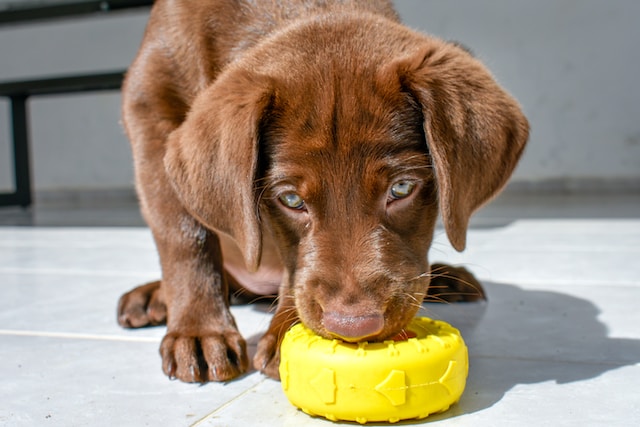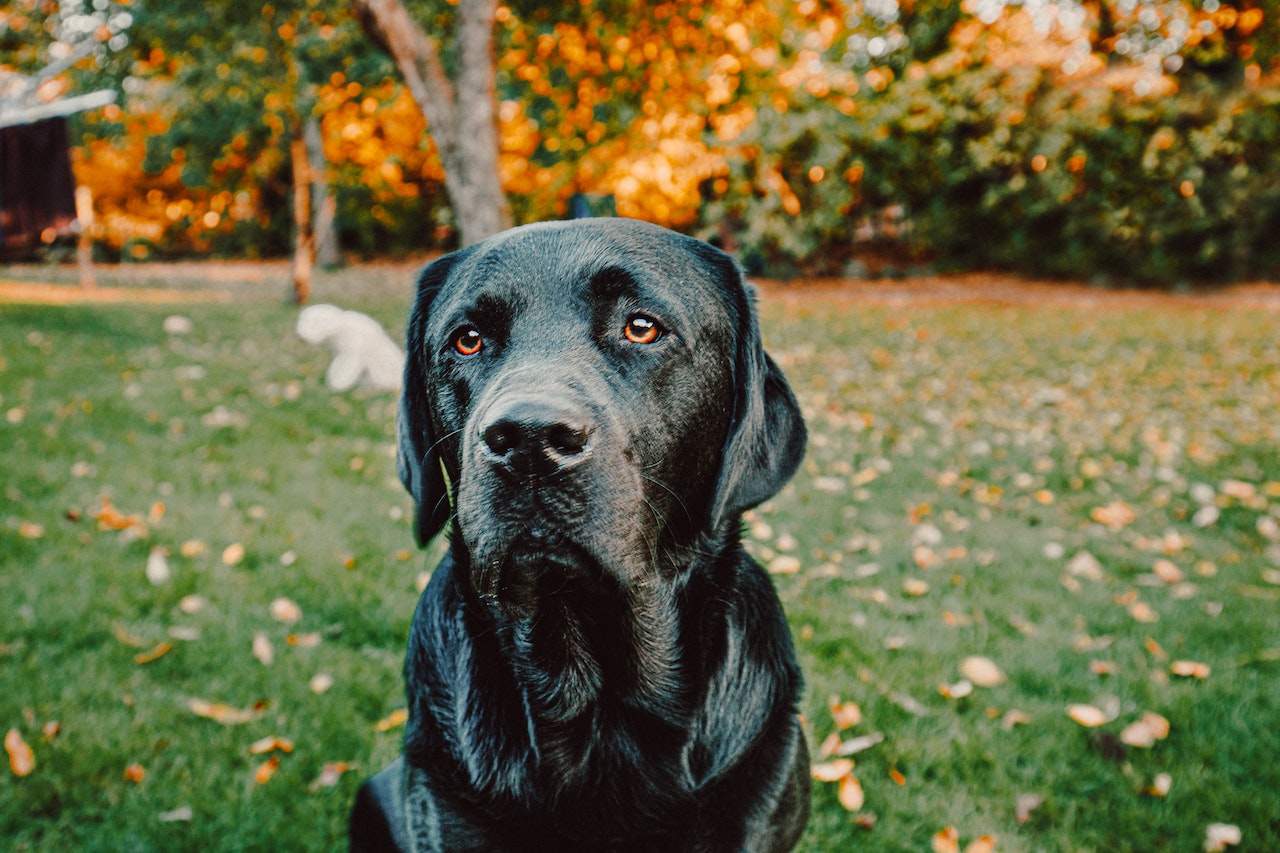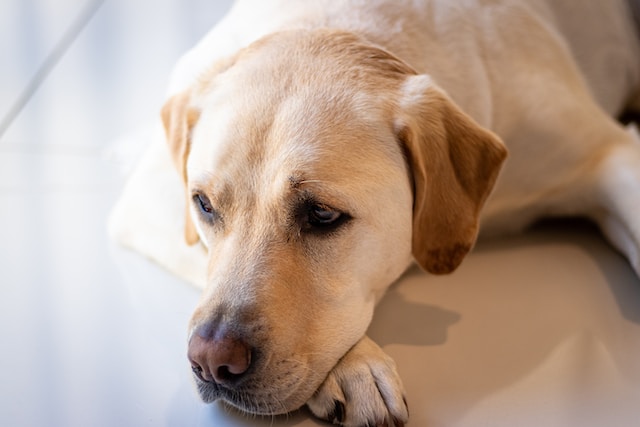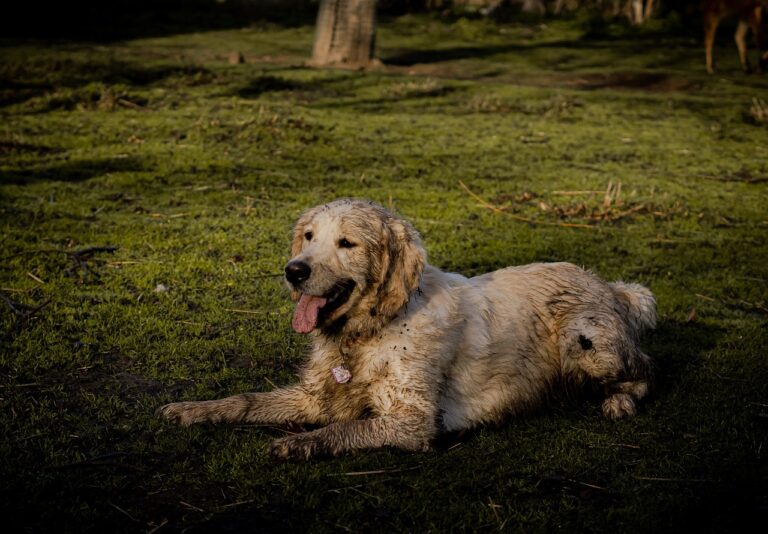Are Labradors Prone To Separation Anxiety?
Do you ever wonder why Labradors seem to have an unbreakable bond with their owners? Their warm eyes and wagging tails are enough to melt even the coldest of hearts. But behind that joyful characteristic, there may be a hidden struggle that many Labrador owners face: separation anxiety. In this blog, we’ll explain the most popular question about Labs: “Are Labradors more susceptible to this condition than other breeds?”.
So get ready to gain insights that will not only deepen your understanding of these remarkable canines but also strengthen the bond you share with your loyal Labrador companion. Let’s dive in and uncover the secrets of their velcro hearts.
How High Is The Chance of A Labrador Having Separation Anxiety
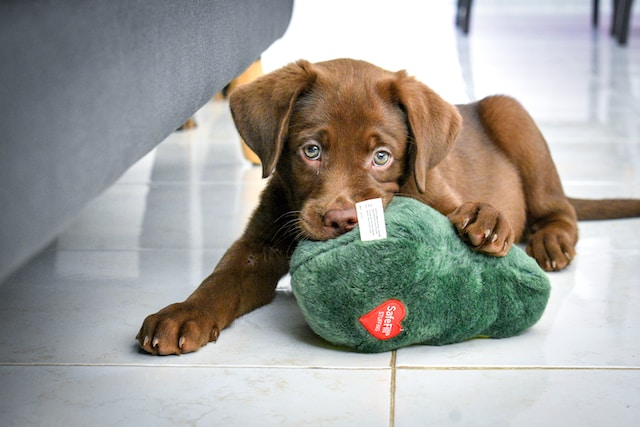
Labradors are known to be a breed that can experience separation anxiety, although the likelihood and severity can vary from dog to dog. Separation anxiety is a condition in which a dog becomes distressed or anxious when separated from their owner or left alone. While Labradors are generally friendly, sociable, and adaptable, these very qualities can contribute to their vulnerability to separation anxiety.
Labradors are often described as “velcro dogs” because they tend to form strong bonds with their owners and enjoy being in their presence. When left alone, they may feel anxious and stressed due to the separation. Factors such as genetics, early socialization, past experiences, and the individual temperament of the dog can also influence the likelihood of developing separation anxiety.
To learn more about the factors that may trigger your Lab’s separation anxiety, check out the next section.
Factors Contributing To Labradors’ Susceptibility To Separation Anxiety
Several factors can contribute to Labradors’ susceptibility to separation anxiety. Here are some possible reasons:
🟦 Breeding and genetics
Labradors have been selectively bred as companion dogs, which has fostered their strong bond with humans. However, this bond can also make them more prone to separation anxiety. Genetic factors can play a role in the development of anxiety disorders, including separation anxiety, in Labradors.
🟦 Socialization and early experiences
Adequate socialization during a Labrador’s early development stages is vital. Puppies that are not exposed to various environments, people, and animals may struggle with anxiety when faced with unfamiliar situations or separation from their owners. Early positive experiences help build confidence and resilience, reducing the likelihood of separation anxiety.
🟦 Gradual desensitization
Gradual desensitization is crucial in teaching Labradors to cope with being alone. Introducing them to short periods of separation from their owners in a controlled and positive manner helps them learn that being apart is not a cause for distress. Failure to gradually acclimate them to alone time can lead to heightened anxiety when left alone.
🟦 Traumatic experiences
Traumatic events or negative experiences can contribute to separation anxiety in Labradors. Instances such as abandonment, sudden rehoming, or significant changes in their environment, can leave lasting emotional imprints, causing fear and anxiety when left alone.
🟦 Lack of exercise and mental stimulation
Labradors are an energetic and intelligent breed that requires regular physical exercise and mental stimulation. Insufficient physical activity and mental engagement can lead to boredom and excess energy, which can manifest as anxiety when they are left alone. Providing outlets for their energy and challenging their minds through activities can help alleviate anxiety.
🟦 Owner behavior and routines
Labradors are sensitive to their owner’s behavior and routines. If owners are overly dependent on their dogs or provide constant attention without establishing boundaries, it can contribute to separation anxiety. Inconsistency in daily routines or frequent changes in the household dynamic can also trigger anxiety in Labradors, as they thrive on stability and predictability.
It’s important to remember that while these factors can contribute to a Labrador’s susceptibility to separation anxiety, individual dogs may exhibit varying degrees of vulnerability.
Different Types of Separation Anxiety in Labradors
When it comes to separation anxiety in Labradors, there are a few different types or manifestations of the condition that can occur. Understanding these types can help you identify and address the specific challenges your Labrador may be facing. Here are three common types of separation anxiety in Labradors:
🟩 Mild Separation Anxiety
Dogs with mild separation anxiety may display subtle signs of distress when left alone. They might become restless, pacing back and forth or whining softly. These Labradors often exhibit clingy behavior when their owners are present, constantly seeking attention or following them around the house. Mild cases of separation anxiety can typically be managed through positive reinforcement training and gradual desensitization techniques.
🟩 Moderate Separation Anxiety
Labradors with moderate separation anxiety exhibit more pronounced signs of distress when separated from their owners. They may engage in excessive barking or howling, exhibit destructive behavior like chewing furniture or scratching doors, and may have accidents indoors. These dogs often become visibly anxious or agitated, and their behavior may escalate as the duration of separation increases.
Moderate cases of separation anxiety may require a combination of behavior modification techniques, environmental enrichment, and possible medication under the guidance of a professional.
🟩 Severe Separation Anxiety
Severe separation anxiety is characterized by intense and extreme reactions when Labradors are left alone. Dogs with severe separation anxiety may exhibit frantic or panicked behavior, such as non-stop barking or howling, causing significant damage to furniture or doors, self-injury, or excessive drooling. They may also display symptoms of generalized anxiety, including excessive panting, trembling, or incessant pacing. In severe cases, the dog’s distress may persist throughout the entire duration of separation.
Treating severe separation anxiety often requires a comprehensive approach, including behavior modification techniques, professional guidance, and potential medication to manage anxiety symptoms.
Recognizing Separation Anxiety in Labradors
Here are some signs to look out for that may indicate separation anxiety in Labradors:
🟧 Excessive vocalization
Labradors with separation anxiety may bark, howl, or whine excessively when left alone. This behavior is their way of expressing distress and trying to call their owner back. The vocalization may continue for an extended period or even throughout the duration of the owner’s absence.
🟧 Destructive behavior
When Labradors experience separation anxiety, they may engage in destructive behavior, such as chewing on furniture, pillows, shoes, or other household items. They may also scratch doors or windows, dig at carpets, or tear apart bedding. These actions are often an attempt to escape or alleviate anxiety. Labradors may focus their destructive behavior near exit points like doors and windows.
🟧 House soiling
Some Labradors with separation anxiety may urinate or defecate inside the house, even if they are otherwise well-trained. This behavior can be a result of anxiety or a response to the stress of being alone. It is important to rule out any underlying medical conditions that may contribute to house soiling.
🟧 Excessive salivation
Labradors may drool excessively when suffering from separation anxiety. This can be observed as wet patches or drool marks on the floor, furniture, or around areas where the dog spends most of its time. The level of salivation can vary from mild to quite severe, depending on the individual dog.
🟧 Pacing and restlessness
If a Labrador is constantly pacing, excessively moving around, or unable to settle down when left alone, it may be a sign of separation anxiety. This behavior is often a manifestation of their anxiety and restlessness. They may repeatedly walk back and forth, circle the room or exhibit signs of uneasiness.
🟧 Escape attempts
Labradors with separation anxiety may try to escape from their confinement areas, such as crates, rooms, or even the house itself. They may scratch at doors, windows, or other barriers, dig under fences, or attempt to squeeze through small openings in an effort to find their owner. Escaping is their way of trying to reunite with their loved ones.
🟧 Loss of appetite
In some cases, Labradors with separation anxiety may lose their appetite or show a decreased interest in food when left alone. This can be a result of stress or a general feeling of unease. The Labrador may refuse to eat their meals or may eat significantly less than usual.
🟧 Excessive excitement upon the owner’s return
When Labradors with separation anxiety finally reunite with their owner after a period of separation, they may display exaggerated excitement. They may jump, bark, lick, and show overall hyperactive behavior. While this behavior may seem positive, it is actually a response to the extreme stress they experienced during the separation.
If you suspect that your Labrador is experiencing separation anxiety, it is crucial to consult with a veterinarian or a professional dog behaviorist.
Potential Consequences Of Untreated Separation Anxiety In Labradors
Untreated separation anxiety in Labradors can have several potential consequences, both for the dog’s well-being and for the owner’s household. Here are some possible outcomes:
🟥 Emotional distress
Labradors with separation anxiety can experience severe emotional distress when left alone. They may exhibit signs of anxiety such as excessive drooling, trembling, panting, or salivating excessively. This distress can be highly distressing for the dog and may lead to long-term psychological effects if left untreated.
🟥 Property damage
Dogs with separation anxiety often engage in destructive behaviors as a way to cope with their anxiety. Labradors, in particular, have strong jaws and a natural inclination to chew. When left alone, they may chew on furniture, doors, walls, or other household items. This can result in significant damage to the owner’s property and can be expensive to repair or replace.
🟥 Escape attempts
Labradors are known for their intelligence and problem-solving abilities. When experiencing separation anxiety, they may try to escape from their environment in an attempt to find their owner. This can involve scratching or chewing through doors, windows, or fences. In the process, the dog may injure itself, risk encountering dangerous situations outside, or become lost, leading to further distress for both the dog and the owner.
🟥 Aggression
While separation anxiety typically manifests as fear and anxiety, in some cases, it can trigger aggressive behavior in Labradors. This aggression may be directed toward other animals, humans, or even themselves. The dog may growl, snap, or bite in an attempt to protect itself or alleviate its anxiety. It’s important to address this aggression promptly to ensure the safety of everyone involved.
🟥 Relationship strain
Living with a dog suffering from untreated separation anxiety can put a significant strain on the relationship between the owner and the pet. The constant damage, disruption, and stress caused by the dog’s behaviors can lead to frustration, resentment, and feelings of helplessness for the owner. This strain can diminish the quality of the human-animal bond and create a negative environment for both the dog and the owner.
🟥 Increased anxiety in other situations
If separation anxiety goes untreated, it can generalize to other situations and trigger anxiety responses even when the owner is present. This means that the dog may become anxious or restless even during routine activities, such as car rides, visits to the veterinarian, or encounters with unfamiliar people or animals. This heightened anxiety can significantly impact the dog’s overall well-being and enjoyment of daily life.
Strategies To Alleviate Separation Anxiety In Labradors
Here are some unique strategies to help alleviate separation anxiety in Labradors:
| Strategy | Tools You Need | How To Do It |
|---|---|---|
| Gradual desensitization | Timer or clock | 1. Start by leaving your Labrador alone for a very short period, such as a few minutes. 2. Gradually increase the duration over time, extending it by a few minutes for each session. 3. Use a timer or clock to track the time accurately. 4. Reward your Labrador with treats and praise for calm behavior during each session. 5. Repeat the process until your Labrador can comfortably tolerate being alone for longer periods. |
| Create a safe space | Dog bed, blankets, toys, and items with your scent | 1. Choose a specific area in your home as a safe space for your Labrador. 2. Place a comfortable dog bed and blankets in that area. 3. Provide toys and items that have your scent, such as old t-shirts or blankets. 4. Introduce your Labrador to the safe space and encourage them to spend time there even when you're present. 5. This will create a positive association with the space and help them feel secure when you're away. |
| Interactive toys and puzzles | Interactive toys, puzzle games, treat-dispensing toys | 1. Purchase interactive toys and puzzle games designed for dogs. 2. Choose toys that require mental engagement and can dispense treats. 3. Fill the toys with treats or kibble. 4. Give the toys to your Labrador before you leave. 5. The toys will keep them occupied and mentally stimulated, redirecting their focus from anxiety to the activity. |
| Calming music or white noise | Music player, white noise machine | 1. Set up a music player or white noise machine in the area where your Labrador spends most of their time. 2. Choose calming music or nature sounds that are specifically designed to relax dogs. 3. Leave the music or white noise on when you're away. 4. The soothing sounds will help mask outside noises and create a calming atmosphere for your Labrador. |
| Counter-conditioning | Treats, toys | 1. Identify the cues that trigger your Labrador's anxiety, such as picking up keys or putting on a coat. 2. Associate these cues with positive experiences by giving treats or engaging in a fun activity before you leave. 3. Repeat this process consistently. 4. Over time, your Labrador will start to develop positive associations with the departure cues, reducing their anxiety. |
| Doggy daycare or a pet sitter | Research local doggy daycare facilities, find a pet sitter | 1. Research and find a reputable doggy daycare facility near you. 2. Visit the facility to ensure it meets your standards and observe how they interact with dogs. 3. Enroll your Labrador in the daycare program. OPTIONAL -Search for a professional pet sitter who has experience with separation anxiety. -Interview potential pet sitters and ask for references. -Choose a pet sitter that you feel comfortable with and who understands your Labrador's needs. |
| Desensitization to departure cues | Departure cues (keys, coat) | 1. Begin by exposing your Labrador to the departure cues without actually leaving. For example, pick up your keys and put them down without going out. 2. Repeat this process several times a day. 3. Gradually increase the intensity by picking up the keys and stepping out briefly. 4. Continue to increase the duration and intensity as your Labrador becomes more comfortable. |
| Use technology | Pet monitoring system, interactive treat dispenser | 1. Install a pet monitoring system or camera that allows you to check on your Labrador remotely. 2. Some advanced systems have features like audio and treat dispensers. 3. Use these features to interact with your Labrador when you're away. 4. The interaction and treats can provide reassurance and engagement, helping to alleviate separation anxiety. |
Preventing Separation Anxiety in Labradors
Separation anxiety is a common issue in Labradors and can cause distress for both the dog and its owner. Fortunately, there are several steps you can take to help prevent separation anxiety in Labradors:
🟨 Create a positive association
Make your Labrador’s alone time a positive experience. Before leaving, provide special treats or toys that they only get when they are alone. This will help them associate being alone with something enjoyable. Interactive toys, such as puzzle feeders or treat-dispensing toys, can keep them engaged and mentally stimulated while you’re away.
🟨 Establish a routine
Dogs thrive on routine, so establish a consistent schedule for feeding, exercise, and alone time. Set specific times for meals, walks, playtime, and rest. This predictability can help reduce anxiety and make your Labrador feel more secure. Stick to the routine as much as possible, even on weekends or days off.
🟨 Provide mental and physical stimulation
Labradors are an active breed that requires both physical and mental stimulation. Regular exercise is crucial for their well-being and can help prevent anxiety. Ensure they get daily walks, playtime, and opportunities to explore their environment. Engage them in activities that challenge their mind, such as obedience training, puzzle toys, or interactive games.
🟨 Use crate training
Crate training can provide a safe and secure space for your Labrador when you’re not at home. Introduce the crate gradually and associate it with positive experiences, such as treats or feeding. Make the crate comfortable and inviting with a cozy bed or blanket. Use the crate when you’re at home as well, so your Labrador doesn’t associate it solely with your absence.
🟨 Avoid making a big fuss
When leaving or returning home, keep your greetings low-key. Making a big fuss during departures or arrivals can heighten your Labrador’s anxiety. Instead, try to maintain a calm and neutral demeanor. Ignore any excessive excitement or clinginess when you leave or come back. By doing so, you’re teaching your Labrador that your departures and returns are not significant events.
🟨 Provide a safe environment
Ensure your Labrador has a safe and secure environment to stay in while you’re away. Remove any potential hazards or objects that they could destroy or ingest. Labrador Retrievers are known for their chewing tendencies, so provide appropriate chew toys and consider using baby gates or closing off access to certain areas of your home until they can be trusted alone.
🟨 Socialization
Proper socialization plays a vital role in preventing separation anxiety. Expose your Labrador to various environments, people, and other dogs from a young age. Gradually increase the level of difficulty in social situations to build their confidence and resilience. A well-socialized dog tends to be more adaptable and less prone to anxiety when left alone.
🟨 Counter-conditioning
If your Labrador already shows signs of mild separation anxiety, counter-conditioning can be helpful. This technique involves associating the triggers of anxiety (such as picking up your keys or putting on your coat) with positive experiences. For example, repeatedly picking up your keys without leaving and offering treats or playtime can help change their emotional response to these triggers.
🟨 Calming aids and supplements
There are various calming aids and supplements available that can help reduce anxiety in dogs. Pheromone diffusers, such as Adaptil, release synthetic pheromones that mimic the ones produced by a lactating mother dog, creating a sense of security. Calming supplements containing natural ingredients like chamomile or valerian root can also have a calming effect. Consult with your veterinarian to determine if any of these options are suitable for your Labrador.
🟨 Seek professional help
If your Labrador’s separation anxiety persists or worsens despite your efforts, it may be beneficial to seek guidance from a professional dog trainer or animal behaviorist. They can assess your dog’s specific needs and provide personalized advice and techniques to address the issue effectively. In severe cases, medication prescribed by a veterinarian might be necessary to help manage anxiety while working on behavior modification.
Remember, every dog is unique, and what works for one Labrador may not work for another. Be patient, consistent, and compassionate throughout the process, and don’t hesitate to seek professional guidance if needed. With time, effort, and the right strategies, you can help your Labrador overcome separation anxiety and enjoy a happier, more relaxed life.
How Long To Treat Separation Anxiety in Labradors
The duration of treatment for separation anxiety in Labradors can vary depending on the individual dog and the severity of their anxiety. It’s important to understand that anxiety is a complex issue that may take time and consistent effort to address effectively.
In some cases, mild separation anxiety in Labradors can be managed and improved within a few weeks or months with appropriate training and behavior modification techniques. However, more severe cases may require a longer duration of treatment, potentially taking several months or even longer to see significant improvement.
Consistency and patience are key when treating separation anxiety. It involves gradually desensitizing the dog to being alone, counter-conditioning their response to departures and arrivals, and providing them with a safe and enriched environment. The goal is to help the dog feel more comfortable and secure when left alone.
Final Words
In conclusion, Labradors are known to be more prone to separation anxiety compared to other dog breeds. Their loyal and affectionate nature often makes them highly attached to their human family members, causing distress and anxiety when left alone. Labradors thrive on human companionship and can become anxious, destructive, or exhibit excessive barking when separated for extended periods.
But hey, don’t worry too much because not all Labradors will develop separation anxiety. It’s all about early socialization and training. By establishing a routine, using positive reinforcement techniques, and gradually exposing them to alone time, you can help your Labrador feel more comfortable and secure when you’re away.
If you’re a proud Labrador parent or thinking about bringing one into your home, keep in mind the potential for anxiety. Remember to provide plenty of mental and physical stimulation, companionship, and a safe environment. And hey, if you’re facing difficulties, don’t hesitate to reach out to a professional dog trainer or behaviorist for guidance. With a little care and attention, Labradors can overcome separation anxiety and lead balanced, happy lives even when you’re not around.
To learn more about calming your Labrador, just click here!

